Barber J.R. Intermediate Mechanics of Materials
Подождите немного. Документ загружается.

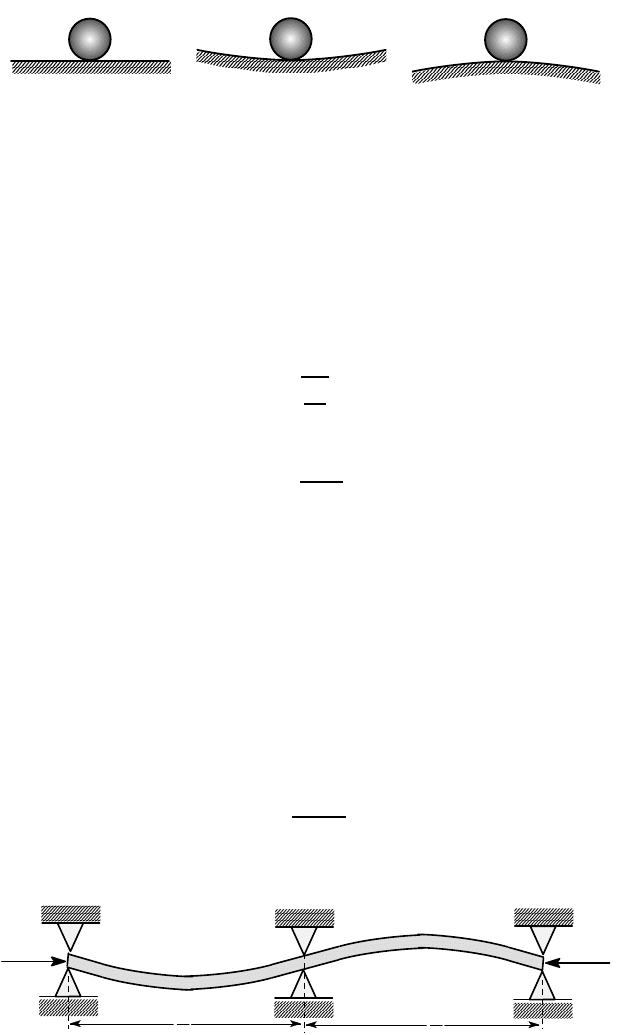
12.1 Uniform beam in compression 515
Figure 12.4: The ball resting on (a) a horizontal surface (neutrally stable); (b) a
concave surface (stable) and (c) a convex surface (unstable)
The neutrally stable system of Figure 12.4 (a) is intermediate between those of
Figures 12.4 (b,c) and we should therefore not be surprised to find that the neutrally
stable configuration of Figure 12.3 (b) is intermediate between domains of stability
and instability. In other words, if
λ
L <
π
, the only solution (A =B = 0) of equations
(12.8, 12.9) is stable, whereas if
λ
L>
π
it is unstable. We shall prove this result using
an energy argument in §12.7.2 below.
The lowest critical force P
0
for neutral stability is defined by
λ
L =
r
P
0
EI
L =
π
(12.12)
and hence
P
0
=
π
2
EI
L
2
. (12.13)
If P>P
0
the system is unstable, if P <P
0
it is stable and if P=P
0
it is neutrally stable.
The higher modes corresponding to
λ
L= 2
π
, 3
π
, etc are unattainable unless the
system is somehow constrained to inhibit the lowest mode. This can be done by
adding a simple support at the mid-point z=L/2, since the solution
u = Bsin(2
π
z/L) , (12.14)
corresponding to
λ
L=2
π
is zero at z=L/2, whereas that corresponding to
λ
L=
π
is
u = Bsin(
π
z/L) , (12.15)
which is non-zero everywhere except at the end supports. Thus, with a support at the
mid-point, the beam will first buckle at the higher force
P =
4
π
2
EI
L
2
, (12.16)
corresponding to
λ
L=2
π
and the buckled shape will be of the form shown in Figure
12.5.
Figure 12.5: Second buckling mode for the simply supported beam
(a) (b) (c)
P
P
L
2
L
2
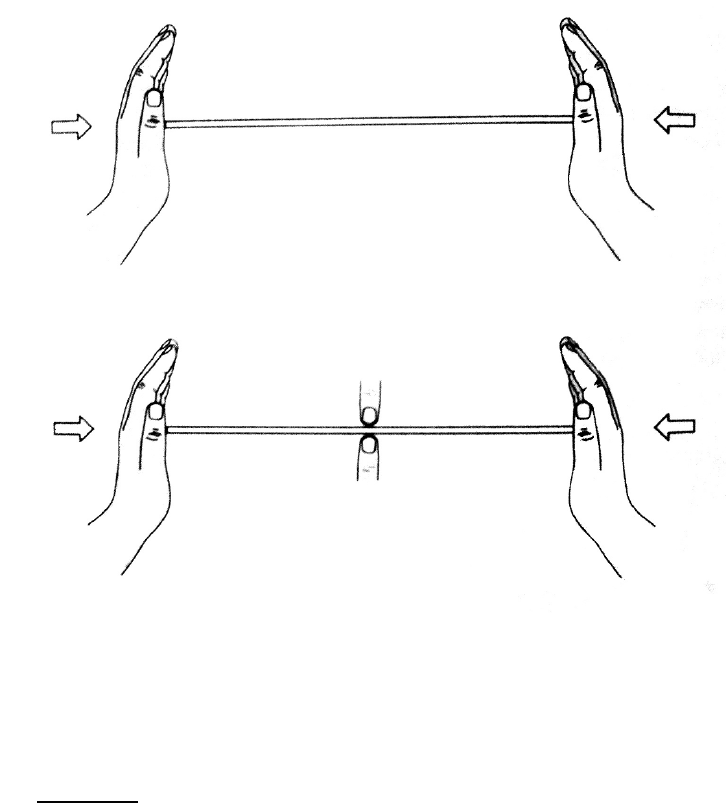
516 12 Elastic Stability
The reader is encouraged to confirm these results by experiment. A thin plastic
ruler is suitable as an experimental beam. Alternatively, you can make one by cutting
a 1 inch ×10 inch strip of fairly substantial cardboard, such as the backing from a pad
of writing paper. Load the beam in compression between the two hands, taking care
not to restrain rotation of the ends, as shown in Figure 12.6 (a). Observe the lowest
buckling mode and retain a physical impression of the required buckling force. Now
get a friend
2
to restrain the mid-point of the beam by lightly pinching it between two
fingers, as in Figure 12.6 (b).
(a)
(b)
Figure 12.6: Buckling experiment (a) the simply supported beam; (b) with a central
restraint
You should find that a substantially larger force is now required to buckle the
beam and the buckling mode is a complete sine wave, as in Figure 12.5. You should
also discover that very little restraint is needed at the centre support to achieve this
result. In fact, if the beam and the supports are perfectly aligned, this reaction is
theoretically zero. From a design point of view, we might therefore expect to be
2
If you have no-one to help you, compress the beam by pushing it with one hand against a
rigid surface, so as to have a hand free for the central support.
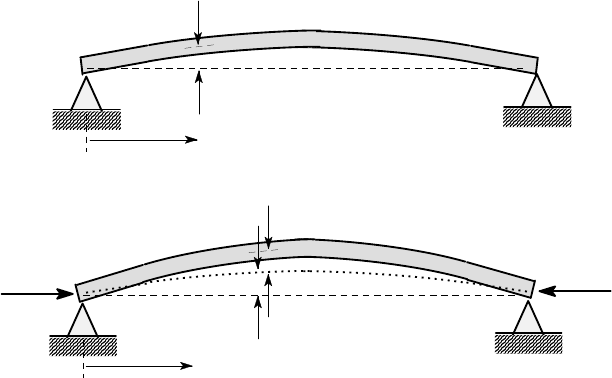
12.2 Effect of initial perturbations 517
able to increase the load carrying capacity of compression members by providing
arbitrarily flimsy intermediate supports. This is not strictly true and we shall return
to this issue in §12.5 below. However, it is true that design against elastic instability
is best achieved by the judicious placing of supports to suppress low order buckling
modes.
Equation (12.10) has a denumerably infinite set of solutions
λ
L = n
π
where n
is any positive integer. The deflected shape corresponding to these solutions will
cross the axis (n−1) times in the length of the beam and the nth mode can only be
generated if supports are placed at all these nodes.
The problem considered above is a classical eigenvalue problem. It defines a
problem through a homogeneous set of equations [in this case equations (12.3, 12.6,
12.7)], which are homogeneous since the right-hand sides are zero. These equations
have only a trivial (null) solution, except for certain eigenvalues of the force P. At
these eigenvalues, the solution has a form u(z) known as the eigenfunction, but any
linear multiple of this function is a solution, as is shown in this case by the fact that
the arbitrary constant B can take any value. It is typical of eigenfunctions that the
nth eigenfunction crosses zero (n−1) times. Also, eigenfunctions generally form an
orthogonal set. In the present case, they are Fourier terms, which are orthogonal to
each other.
12.2 Effect o f initial perturbations
Suppose that the beam of Figure 12.2 (a) was not quite straight due to manufacturing
errors. We can describe this initial condition by stating that the beam has a deflection
u
0
(z) even before the compressive force is applied, as shown in Figure 12.7 (a).
(a)
z
u (z)
0
(b)
z
u (z)
0
u(z)
P P
Figure 12.7: Beam with initial perturbation (a) before loading, (b) after loading

518 12 Elastic Stability
We now apply a compressive force P causing an additional deflection u(z), as
shown in Figure 12.7 (b), so that the bending moment at any point is given by
M = P(u + u
0
) . (12.17)
The bending moment-curvature relation here involves only the additional deflection,
u(z), since no moment was needed to establish the state u
0
(z). It follows that M =
−EId
2
u/dz
2
and hence
d
2
u
dz
2
+
Pu
EI
= −
Pu
0
(z)
EI
, (12.18)
from (12.17). Thus, the effect of the initial imperfection is to make the governing
differential equation inhomogeneous.
The general solution of equation (12.18) can be written as the sum of any partic-
ular solution and the general solution of the corresponding homogeneous equation.
If u
0
(z) is a polynomial, trigonometric or exponential function, a particular solution
can be determined by assuming u(z) to have the same general form and then equat-
ing coefficients. The homogeneous equation corresponding to (12.18) is (12.3) and
hence the general homogeneous solution of (12.18) is given by (12.4). The general
solution will contain two arbitrary constants, which are determined from the kine-
matic boundary conditions.
Since the equation is inhomogeneous, some deflection is produced for all values
of the compressive force P, but we shall find that it increases without limit as P
approaches the critical force P
0
of equation (12.13).
Example 12.1
The simply supported beam of Figure 12.7 has length L, flexural rigidity EI and an
initial deflection defined by
u
0
(z) =
4
ε
z(L −z)
L
2
,
where
ε
≪L. Find the deflected shape when the beam is compressed by a force P and
sketch the variation of the maximum deflection with P.
In this case, the differential equation (12.18) takes the form
d
2
u
dz
2
+
Pu
EI
= −
4P
ε
z(L −z)
EIL
2
and the right-hand side is a second degree polynomial, so we seek a particular integral
u
P
(z) of the same form, i.e.
u
P
(z) = C
0
+C
1
z +C
2
z
2
,
where C
0
,C
1
,C
2
are as yet unknown constants.
Substituting u
P
(z) into the governing equation, we obtain
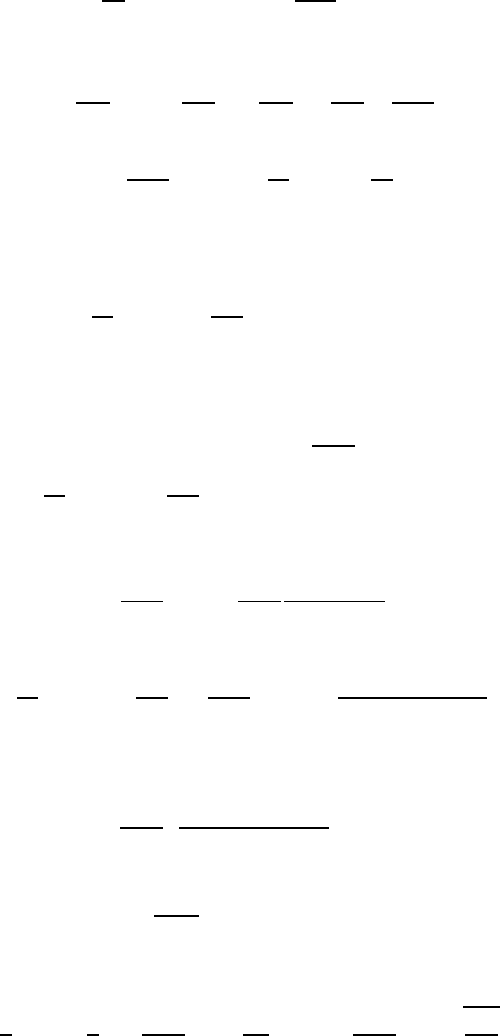
12.2 Effect of initial perturbations 519
2C
2
+
P
EI
(C
0
+C
1
z +C
2
z
2
) =
4P
ε
EIL
2
(z
2
−zL) .
We now equate coefficients of z
0
,z
1
,z
2
, obtaining
2C
2
+
PC
0
EI
= 0 ;
PC
1
EI
= −
4P
ε
EIL
;
PC
2
EI
=
4P
ε
EIL
2
,
with solution
C
0
= −
8
ε
EI
PL
2
; C
1
= −
4
ε
L
; C
2
=
4
ε
L
2
.
The general solution of the governing equation is then obtained by substituting
these results into u
P
(z) and superposing the general homogeneous solution (12.4),
with the result
u(z) =
4
ε
L
2
z
2
−Lz −
2EI
P
+ A cos
λ
z + Bsin
λ
z .
The simply supported boundary conditions u(0) = u(L) = 0 then give the two
equations
−
8
ε
EI
PL
2
+ A = 0
4
ε
L
2
L
2
−L
2
−
2EI
P
+ A cos
λ
L + Bsin
λ
L = 0
for the unknown constants A,B, with solution
A =
8
ε
EI
PL
2
; B =
8
ε
EI
PL
2
(1 −cos
λ
L)
sin
λ
L
and hence
u(z) =
4
ε
L
2
z
2
−Lz −
2EI
P
+
8
ε
EI
PL
2
cos
λ
z +
(1 −cos
λ
L)sin
λ
z
sin
λ
L
.
The deflected shape of the beam due to the compressive force P is therefore
defined by
u(z) + u
0
(z) =
8
ε
EI
PL
2
(1 −cos
λ
L)sin
λ
z
sin
λ
L
−(1 −cos
λ
z)
.
In interpreting this expression, it is important to recognize that the applied
force P appears explicitly in the term 8
ε
EI/PL
2
, but also implicitly in the terms
sin
λ
z,cos
λ
L, etc., since
λ
=
p
P/EI, from (12.5).
The maximum displacement occurs at the mid-point z = L/2, and after some
algebra can be written
u
max
= u
L
2
+ u
0
L
2
=
8
ε
EI
PL
2
sec
λ
L
2
−1
=
8
ε
EI
PL
2
sec
r
PL
2
4EI
−1
!
.
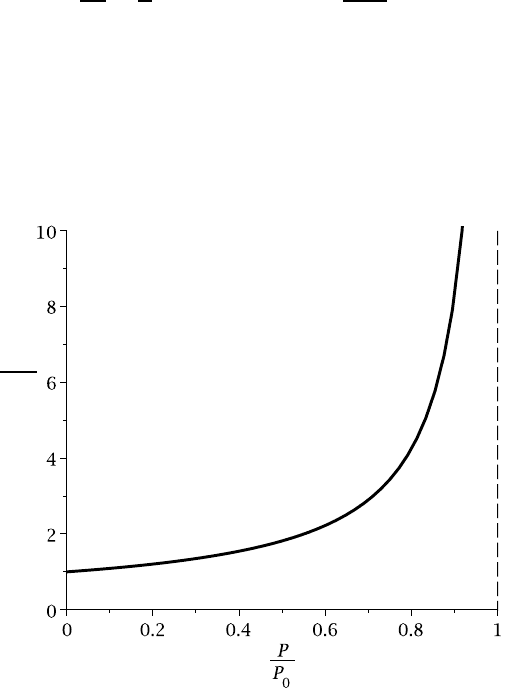
520 12 Elastic Stability
This expression becomes unbounded as
λ
L
2
→
π
2
and hence P →
π
2
EI
L
2
= P
0
,
which is the same critical force determined for the homogeneous problem in equation
(12.13).
The maximum deflection is plotted as a function of the ratio P/P
0
in Figure 12.8.
The deflection is unbounded at P →P
0
, but substantial deflections are produced at
significantly lower compressive forces. No manufacturing process is perfect, so it is
prudent to avoid column designs in which the maximum axial force exceeds 70% of
the theoretical critical force.
Figure 12.8: Central deflection as a function of compressive force
u
max
ε
12.2.1 Eigenfunct ion expansions
In Example 12.1, the constant B →∞ as P →P
0
(
λ
L →
π
), whilst the constant A re-
mains bounded. As a result, the expression for u(z) is increasingly dominated by the
term B sin
λ
z as the critical force is approached, even though the initial perturbation
is not sinusoidal.
This is a general characteristic of eigenvalue problems. As the eigenvalue is ap-
proached, the response to any initial perturbation will grow without limit and the
shape of the resulting functions will approach that of the corresponding eigenfunc-
tion of the homogeneous problem.

12.3 Effect of lateral load (beam-columns) 521
This effect can be made more explicit by expanding the initial perturbation as an
eigenfunction expansion. In the present case, the eigenfunctions are of the sinusoidal
form sin
λ
z, with
λ
L= n
π
[see equations (12.4, 12.8, 12.11)] and hence we write
u
0
(z) =
∞
∑
n=1
C
n
sin
n
π
z
L
, (12.19)
where C
n
is a set of unknown coefficients that can be determined by inverting the
Fourier series (12.19).
Substitution of (12.19) into (12.18) will now yield a differential equation whose
solution can be written in the form
u(z) =
∞
∑
n=1
A
n
sin
n
π
z
L
. (12.20)
The new coefficients A
n
can be found in terms of the C
n
by equating coefficients,
with the result
A
n
= C
n
n
2
π
2
EI
L
2
P
−1
. (12.21)
Now clearly the A
n
will be of the same order as the C
n
except when the denomi-
nator of (12.21) is small compared with unity, which happens for the term A
1
when P
is close to P
0
. Thus, the deflection of the beam [equation (12.20)] will be dominated
by the first eigenfunction when the first critical force is approached, whatever form
is taken by the initial perturbation.
This technique of expressing the ‘forcing term’ (in this case the initial perturba-
tion) as an eigenfunction expansion is mathematically analogous to the expansion of
the response of a dynamic system in terms of normal modes. It depends on the fact
that the eigenfunctions are orthogonal and complete — i.e. that any arbitrary initial
beam shape can be expanded in such a series.
12.3 Effect o f lateral load (beam-columns)
Another class of inhomogeneous stability problems arises if an initially straight beam
is subjected to both axial and lateral loading. Beams loaded in this way are some-
times referred to as beam-columns, since they combine features of traditional beam
bending with axial loading as a column.
The lateral load will produce some lateral deflection even in the absence of the
axial force, but the latter exaggerates the deflection, causing it to go unbounded as
the critical axial force is approached. The axial force also exaggerates the bending
moment due to lateral loading and this effect can be important even when the axial
force is significantly sub-critical. The deformed shape approaches more closely to
the theoretical eigenfunction for purely axial loading as the compressive axial force
is increased.
The analysis of beam-columns proceeds exactly as in the cases considered in
previous sections. We sketch a free-body diagram of the beam in an as yet unknown

522 12 Elastic Stability
deformed configuration and determine the bending moment as a function of z from
equilibrium considerations, taking care to include the moment due to the axial force.
We then substitute the moment into the bending equation, solve the resulting ordinary
differential equation and determine the two arbitrary constants from the kinematic
boundary conditions.
Example 12.2
Figure 12.9 (a) shows a uniform cantilever beam of flexural rigidity EI and length L,
loaded by an axial force P and a lateral force F at the free end. Find the maximum
bending moment in the beam and sketch its variation with P for a given value of F.
(a)
P
F
L
z
(b)
P
P
M
u(z)
u(L)
F
F
L - z
Figure 12.9: (a) Cantilever loaded by an axial force and a lateral force; (b) free-body
diagram for a beam segment
Figure 12.9 (b) shows the free body diagram for a segment of the beam of length
z at the loaded end. It is clear that the axial force and the shear force at the cut must
be P and F, respectively, and taking moments about the cut we have
M = −P [u
L
−u(z)] −F(L −z) ,
where u
L
= u(L) is the displacement at the end z = L. Notice in particular that the
moment arm for the force P [the perpendicular distance between the two equal and
opposite forces P in Figure 12.9 (b)] is [u
L
−u(z)], rather than simply u(z) as in Ex-
ample 12.1. This is because the end is unsupported and therefore has a non-zero
deflection u
L
. Also, it is convenient to treat u
L
as a separate unknown at this stage,
only imposing the condition u
L
= u(L) when the boundary conditions are being ap-
plied.
The governing equation is
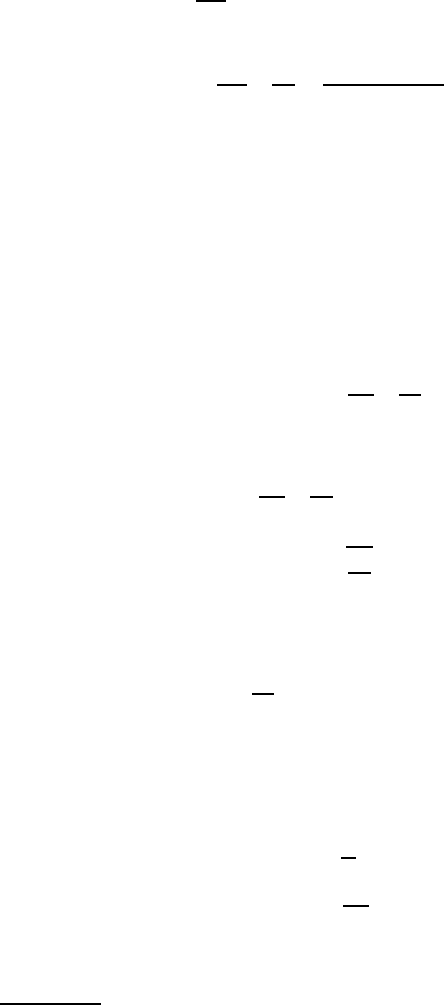
12.3 Effect of lateral load (beam-columns) 523
EI
d
2
u
dz
2
= −M = P [u
L
−u(z)] + F(L −z)
and hence
d
2
u
dz
2
+
Pu
EI
=
Pu
L
+ FL −Fz
EI
.
Notice how this equation has the same form as the inhomogeneous equation (12.18),
only the right-hand side being different. In general, for any stability problem for
straight beams, the left-hand side of the governing equation [i.e. the terms containg
the unknown displacement function u(z)] will be identical to that in (12.18) and
hence the corresponding homogeneous equation will always be (12.3). This provides
a useful check on the sign convention. If you end up with (d
2
u/dz
2
−P/EI) as the
left-hand side, you have almost certainly
3
made a sign error and would do well to
check carefully before proceeding.
The right-hand side of the governing equation is a first order polynomial in z and
elementary calculations show that a suitable particular solution is
u
P
(z) = u
L
+
FL
P
−
Fz
P
.
The general solution is obtained by superposing the homogeneous solution (12.4)
and is
u(z) = u
L
+
FL
P
−
Fz
P
+ A cos
λ
z + Bsin
λ
z ,
where
λ
=
r
P
EI
.
In this case, there are three unknowns A,B,u
L
, which can be determined from the
two kinematic boundary conditions
du
dz
= u = 0 ; z = 0
and the definition
u = u
L
; z = L .
Substituting for u(z), we obtain the three simultaneous algebraic equations
−
F
P
+ B
λ
= 0
u
L
+
FL
P
+ A = 0
u
L
+ A cos
λ
L + Bsin
λ
L = u
L
,
with solution
3
The exception is if the axial force is tensile instead of compressive. See for example, Prob-
lem 12.8.
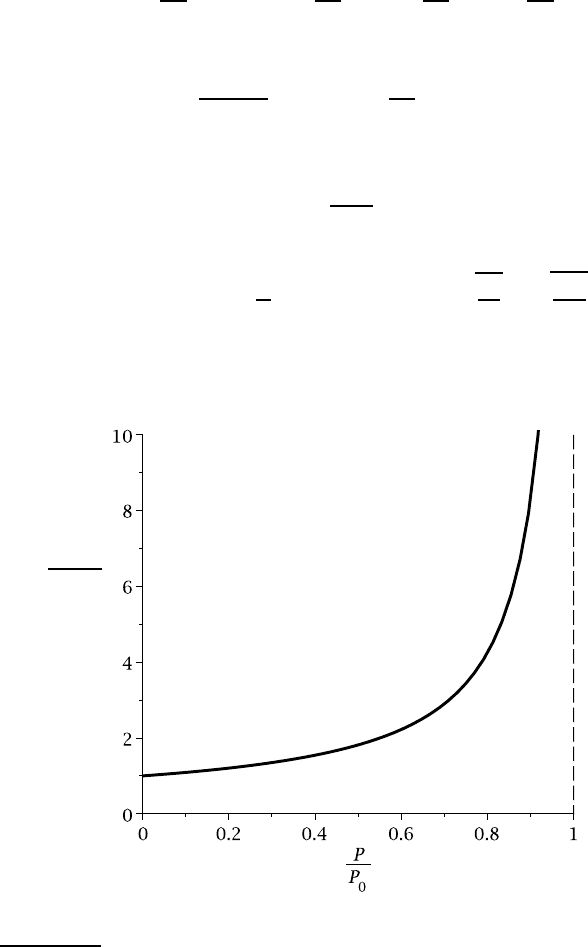
524 12 Elastic Stability
A = −
F
P
λ
tan
λ
L ; B =
F
P
λ
; u
L
=
F
P
λ
tan
λ
L −
FL
P
.
Substituting these results into the expression for u(z), we obtain
4
u(z) =
F tan
λ
L
P
λ
(1 −cos
λ
z) −
F
P
λ
(
λ
z −sin
λ
z) .
The first term in this expression increases without limit as
λ
L→
π
/2, correspond-
ing to the critical force
P
0
=
π
2
EI
4L
2
.
The maximum bending moment ocurs at z = 0 and is
|M
max
| = Pu
L
+ FL =
F
λ
tan
λ
L −FL + FL = F
r
EI
P
tan
r
PL
2
EI
.
This is shown as a function of the dimensionless axial force P/P
0
in Figure 12.10.
Notice that the axial force causes a significant increase in the maximum bending
moment for values as low as P=0.2P
0
.
Figure 12.10: Maximum bending moment as a function of axial compressive force
|M
max
|
FL
4
The perceptive reader may be puzzled by the fact that the expression for u(z) contains P
in the denominator and hence appears to be unbounded as P →0. However, in this limit,
λ
also tends to zero and by replacing the trigonometric functions by the first few terms
of their power series expansions, it can be shown that the solution does indeed tend to the
correct expression for a cantilever beam with an end load F, when P →0.
